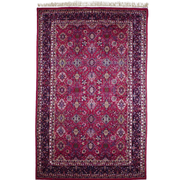Central Anatolia Region Kayseri Natural Bunyan Carpet
Turkmen Bukhara Hand-Woven Carpet
West Anatolia Denizli Baklava Rug
Central Anatolia Taspinar Hand-Woven Carpet
Central Anatolia Afyon Cicim Rug
Central Anatolia Konya Ladik Hand-Woven Carpet
Hand Woven Kazakh Rug
West Anatolia Antique Milas Hand Woven Carpet
Central Anatolia Konya Karapinar Cicim Rugs
West Anatolia Canakkale Ayvacik Hand Woven Carpet
Kazakh Sirvan Hand-Woven Carpet
Hand Woven Central Asian Kazakh Rug
Kayseri Bunyan Vintage Hand Woven Carpet
West Anatolia Balikesir Nomad Rug
Aegean Patchwork Hand Woven Rug
Patchwork from Anatolian Rugs TSH9857463569
East Anatolia Kars Rug
West Anatolia Denizli Cicim Rug
West Anatolia Oushak Esme Rug
West Anatolia Milas Carpet with Double Roses
DYES USED IN TURKISH CARPETS AND RUGS
The dyes used in Turkish carpets and rugs are usually derived from natural sources. Turks have a deep-rooted tradition of natural dyeing and the foundations of this tradition were laid in Central Asia with the birth of carpet art. The Turks, who moved to Anatolia as a result of migrations, continued the tradition of natural dyeing by taking advantage of the rich vegetation of Anatolia.
The preparation of natural dyes usually requires a long and painstaking process. The dyestuffs obtained by collecting, drying, crushing and mixing the plants with water or other binding agents are applied to the yarns of carpets and rugs.
These natural dyes create the unique color palette of Turkish carpets and rugs and reveal the unique character of each piece.
The natural dyes used in Turkish carpets and rugs are not only aesthetic, but also part of a cultural and historical heritage. These traditional dyeing methods make Turkish carpets and rugs unique and valuable worldwide.
The variety of natural dyes used in Turkish carpets and rugs varies depending on regional differences and local vegetation.
Chamomile Chamomile is used as a natural dye in yellow and beige tones. Especially in various regions of Anatolia, the powders obtained by drying and grinding chamomile flowers are used for coloring carpets and rugs.
Saffron Saffron is a natural dye in red, yellow and orange tones. The dried flowers of the saffron plant grown in some regions of Anatolia are used to color carpets and rugs with the powder obtained.
Thyme The leaves of the thyme plant can be used to obtain natural dyes in green and brown tones. This natural dye is widely used, especially in the Aegean region.
Turmeric: The powder from turmeric root provides a natural dye in shades of bright yellow and golden colors. Turmeric is a common dye for coloring carpets and rugs.
Rabbitwort: The roots of the rabbitroot plant are used to produce natural dyes in shades of orange and brown. This natural dye is a traditional coloring agent used especially in Eastern Anatolia.
Onion Skin: Onion peel is used to obtain brown, reddish and yellowish tones. The water obtained by boiling onion peel is used to dye carpets and rugs in a natural way.
Bu doğal boyaların yanı sıra ayva yaprağı, zerdeçal, çitlenbik, dil kanatan otu, palamut kozalağı, cevizli bağ, pıynar, hindiba, sütleğen, nar kabuğu ve ceviz gibi bitkiler bulunur. Bu bitkilerin yaprakları, kökleri, kabukları veya meyveleri kullanılarak çeşitli renkler elde edilir. Anadolu'da başka bitkiler de kullanılarak farklı renk tonları elde edilir. Her bir bitki ve renk, Türk halı ve kilimlerinin benzersiz ve doğal güzelliklerini ortaya çıkarır.
 ">
">
